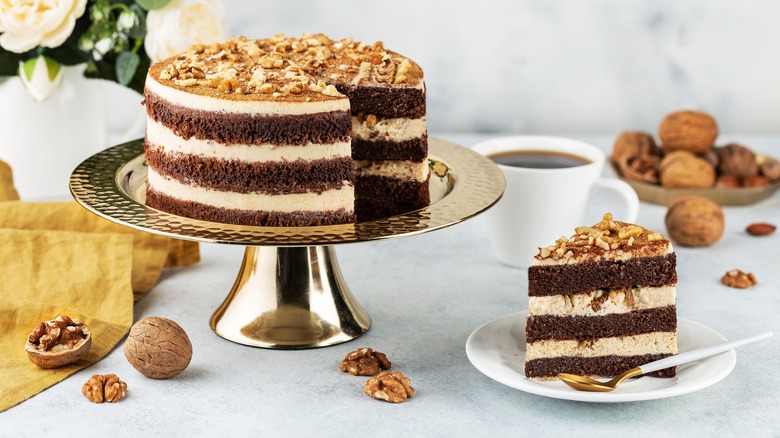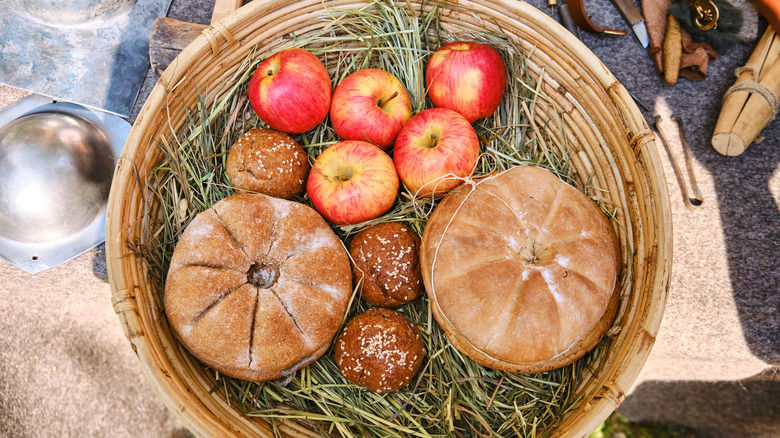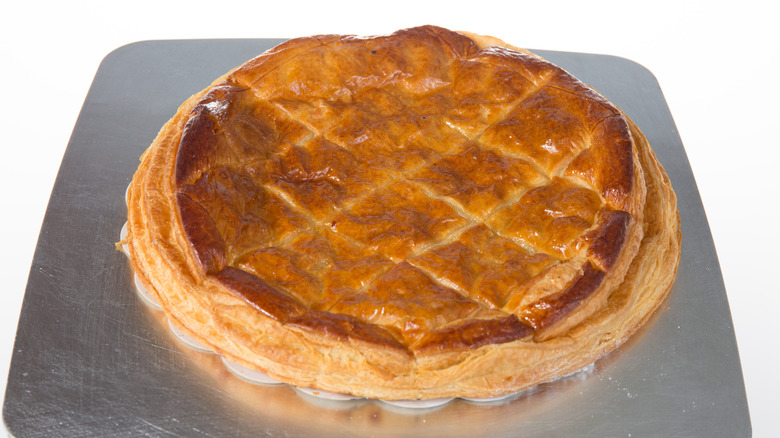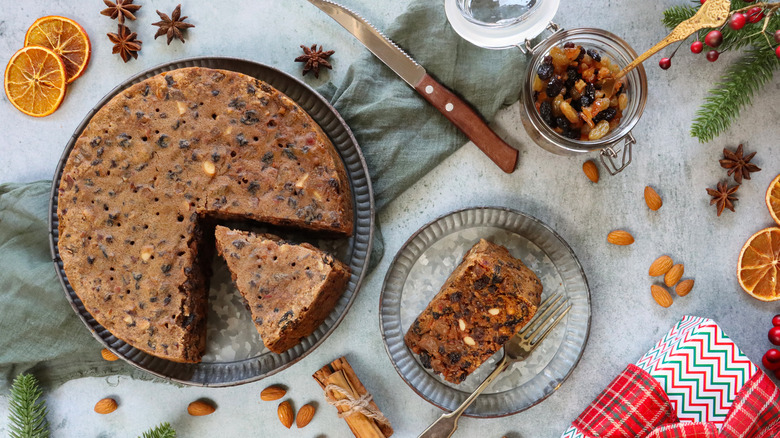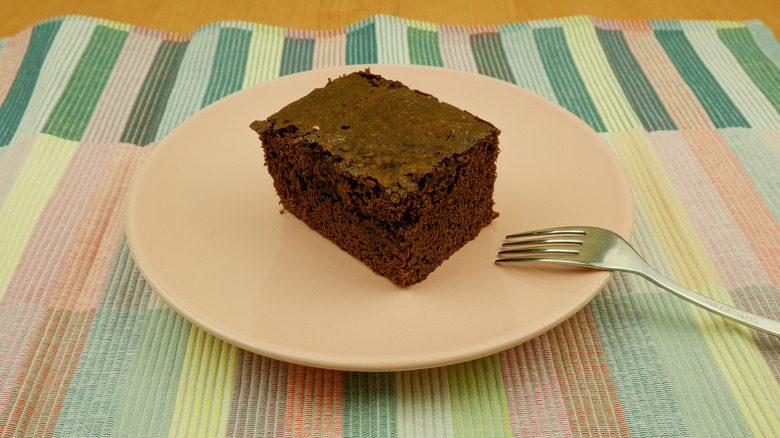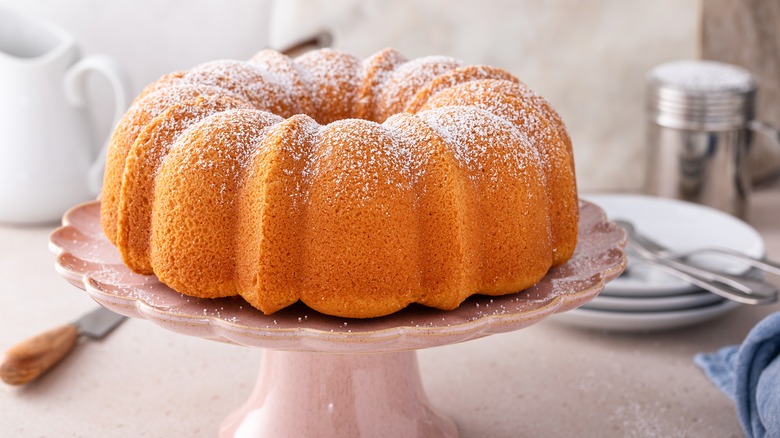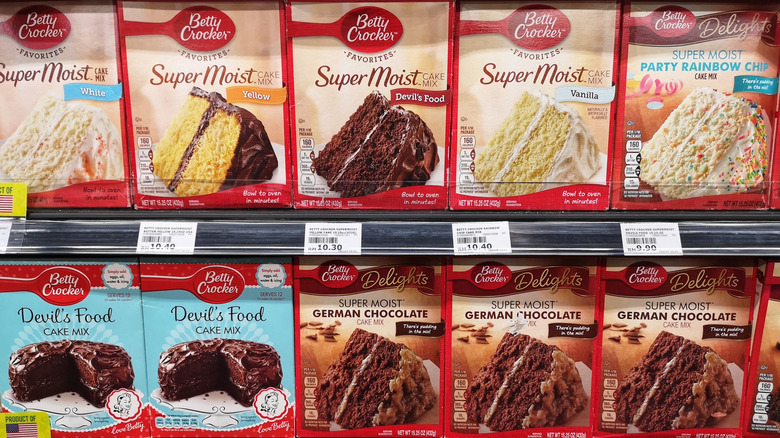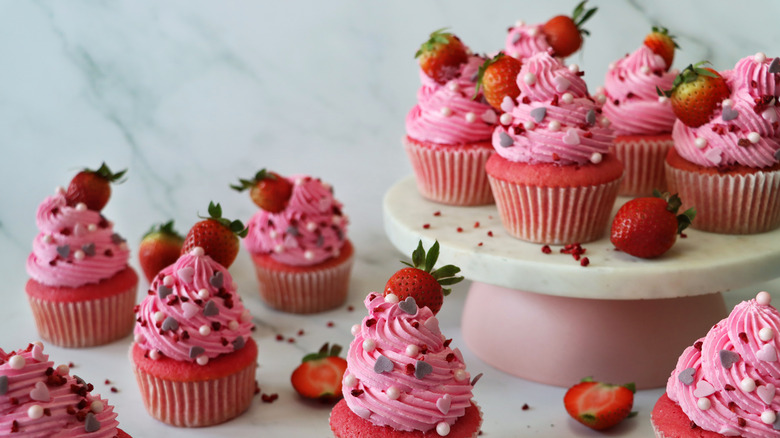History's First Cakes Looked A Whole Lot Different Than What We Have Today
It would be hard to imagine a world without cake. Virtually every special event humans celebrate is commemorated by some variation of the sweet treat. This confectionary delight has a long history of being utilized as a ritual offering to the gods, symbolizing the life cycle of humans and the passage of the seasons.
While the cake is found in cultures across the globe, it takes on various shapes, sizes, and flavors depending upon the individual culinary habits of a group of people. The type of cake a person makes is as representative of where you grew up as it is of distinct family traditions. And as technology has evolved to simplify and economize the production of cake, our capacity to be creative with the designs has morphed, as is evidenced by cake decorating programs and competitions proliferating across our televisions and streaming services.
What might be surprising to some is how different the earliest iterations of cake were from the modern round layered frosted towers of fondant one might see at a wedding reception or birthday party. Many of these primitive cakes were produced by the earliest humans with rudimentary cooking vessels and ovens. Let's look at how cakes have developed from the Neolithic to today.
Ancient Egypt
The earliest known example of something akin to a cake dates back to the Neolithic era. These primitive cultures created small biscuit-like products fashioned from pulverized grains combined with water, formed into patties, and baked on hot stones. From these, unleavened types of bread evolved, which remained the norm until the appearance of ancient Egyptians.
In 2600 B.C. Egyptians discovered yeast and began incorporating it into their breadmaking, revolutionizing how humans baked. These yeast-leavened breads were produced with barley and emmer wheat. The type of yeast used was often a by-product of beer fermentation, which likely conferred a distinct flavor to these breads. A variation of sweetbreads was also made. These were sweetened with honey and supplemented with ingredients like fruit, nuts, seeds, spices, and wine for flavor. These cake-like breads were shaped into spheres, decorated, and then baked, yielding a heavy confection that bears little resemblance to modern-day cakes.
Archaeological evidence from the tomb of Ramses III indicates thousands of different types of bread and cakes were made during this time and frequently left as offerings to the gods. Artistic representations of baking on tomb reliefs, paintings, and models, depict elaborately decorated cake-like bread with designs like date palm leaves and animals. All of these reinforce the importance of baking to Egyptian life, commerce, and ritual, which explains the great strides made in bread and cake baking during this period.
Greeks, Romans, and Chinese
By the time of the ancient Greeks and Romans, baking with yeast had become commonplace. The Greeks and Romans also began incorporating ingredients like eggs, milk, cheese, and olive oil. A traditional Greek cake, plakous, meaning flat, was made with flour, milk, eggs, honey, and nuts. It is likely the precursor to baklava, resembling more of a casserole than a cake.
The Roman Empire took things to an even more elevated level, creating a Baker's Guild known as the Pistorium in 168 B.C. Bakers were considered revered artisans, with an annual baking festival celebrated in honor of the goddess of the oven, Fornax. One of the most popular cakes in the Roman Empire was the placenta. Reminiscent of the Greek plakous, this flat confection made of flour, honey, and cheese featured heavily at birthday parties and was a frequent sacrificial offering during religious rituals.
Cake baking was not limited to ancient Greece and Rome. It spread across Asia, becoming commonplace in China. For example, during the 12th century, a cake honoring the Autumn Moon Festival, known as moon cakes, was instrumental in beginning a revolution there. A resourceful revolutionary named Chu Yuan-chang started scuttlebutt that a plague was imminent and that the only antidote to getting ill was consuming a moon cake.
Within each cake, a note was hidden with information regarding an impending battle to begin the Han overthrow of the Mongols. This clever ruse is yet another example of the centrality of cake within cultures across the globe as baking became increasingly refined.
Medieval to Renaissance Europe
At the beginning of the Medieval era, everyday cakes still resembled those manufactured by the Greeks and Romans. It was not until the Crusades in the 11th century that sugar became available in Europe, and, in the beginning, it was considered a luxury item that could only be afforded by the elite wealthy classes. Brightly colored sweet cakes with many elaborately decorated layers became a status symbol, further dividing the haves and have-nots.
By the Renaissance, sugar was no longer considered a rare commodity, making it more accessible and cost-effective for the average European to incorporate into their daily meals. This resulted in an explosion of sweet treats and a rebirth of cakes into something more sophisticated and recognizable by the cake standards of today.
This era also ushered in newer baking techniques, including unique leavening processes. Yeast often produced dense baked goods, which wasn't as desirable for cake making. Italian chefs began experimenting with beating egg whites into a meringue to incorporate into cakes rendering them less heavy. While this was a laborious and precious process, it yielded fluffier and more delicate cakes. In many ways, these were the precursors to what would eventually become a sponge cake.
17th century
The first versions of a modern circular cake with icing or frosting on top appeared during the 17th century, thanks to some vital technological advances. The first of these was the development of rudimentary cake molds. These circular molds were fashioned out of metal, wood, or paper. Some of these molds were even adjustable, giving bakers far more control over the shape and size of their final products.
The molds were balanced atop a baking sheet and then filled with the cake batter. The whole apparatus would then get placed into the oven to bake. Ovens also had become more reliable by this period allowing for more uniform baking and complexity in recipes.
A second important invention of this era was that of icing, which at first was a boiled concoction made from egg whites, sugar, and flavorings, like rosewater. Once this mixture came together, it would get drizzled atop a baked cake. The glazed cake would then be returned to the oven, where this icing would begin to set atop the dessert.
When the cake was finished, it would be allowed to cool completely, during which this icing would firm up, encasing the cake like a crispy shell. These iced masterpieces would then get garnished with nuts, fruits, seeds, or other intricate decorations. When served at special events, they were often accompanied by sugary beverages, like tea or sweet wine.
Industrial Revolution
With the rapid changes that came during the Industrial Revolution, including the development of the railway system and the streamlining of mass production of goods like sugar and flour, producing a cake could easily be managed by the average home cook quickly and affordably. Perhaps the most indispensable advance of this era came with the invention of leaveners like baking soda and baking powder, which enabled cakes to be baked in a fraction of the time it took to produce yeast-based cakes. This was a game changer for women increasingly beginning to work outside the home.
Another important discovery of this period was how to make chocolate efficiently. In 1764, Dr. James Baker deciphered the method to extract chocolate from cocoa beans by pulverizing them with millstones. By 1828, a mechanized extruder was invented by Conrad Van Houten from the Netherlands, which enabled the separation of the lipids from the cacao liquor. This yielded cocoa butter and pure cacao called "rock cacao," which could be sold whole or crushed into a powder.
And in 1879, legendary chocolatier Rodolphe Lindt from Switzerland stumbled upon the conching method, a type of purification process that removes odd flavors and excess water from chocolate through a lengthy whipping and aerating procedure. This created more homogenized, silky chocolate with a sophisticated flavor and made it easier to incorporate into a cake batter. Chocolate went from a product reserved for the rich to an everyday commodity that could be used by amateur and professional cake bakers alike.
Angel Food cake
Angel Food cake is a decidedly American invention. It likely originated around the early 1800s in southeastern Pennsylvania, where the first Angel Food cake mold evolved. It is believed that the inspiration for this cake came from the popularity of sponge and meringue-focused cakes that took advantage of the Italian invention of beating egg whites to help leaven the batter. Angel Food cake differs from these predecessors in that it only uses egg whites, not the whole egg. To incorporate the ideal fluffiness needed to make this cake as light as air, the egg whites would need to get beaten for an extended period, which required intense labor before the invention of the rotary beater.
This is where the story of Angel Food cake becomes less heavenly. The earliest iterations of this cake were likely produced by enslaved Africans from the South. Indeed, Angel Food cake is still considered a beloved contribution to a post-funeral meal within the African-American community.
Rudimentary rotary beaters appeared on the market in 1865. These models were hand-cranked contraptions with a single beater that wasn't a marked improvement upon hand whisking. It wasn't until 1870 that Turner Williams of Providence, Rhode Island, introduced the dual whisk model, which notably expedited the egg white beating process. By 1884, a recipe for Angel Food cake was included in the debut cookbook published by the Boston Cooking School, permanently entering it into the annals of the American cake-baking legacy.
Depression era cakes
The early half of the 20th century was a tumultuous time for America. Between World War I, the Great Depression, and World War II, food scarcity and rationing significantly impacted the ability to bake a cake. During this era, bakers had to take their knowledge of the basic science of cake-making and adapt recipes with the ingredients they had on hand. From this ingenuity evolved some of the most unusual and delectable concoctions.
One of the first types of cake with this adaptation came from a 1918 pamphlet called "War Economy in Food." In a section dubbed "Recipes for Conservation Sweets," details for a "war cake" were included. This recipe utilized molasses and corn syrup instead of sugar, which was scarce during this time. Other recipes, like "wacky cake," "poor man's cake," and "mayonnaise cake," substituted butter, milk, and eggs with oil, vinegar, baking soda, and mayonnaise, to confer moisture and fluffiness to these cakes.
And in a particularly bold yet effective move, Campbell's condensed tomato soup in a can was transformed into what became known as "magic cake." This baking prestidigitation involved using the acid, pectin, and starch from the tomato soup base to leaven, sweeten, bind, and moisten this culinary delight. And tomatoes were not the only vegetable to find their way into the cake. Carrots were becoming a common substitution for sugar, setting the stage for what would eventually become one of the most popular cakes ever, the carrot cake.
Bundt cakes
Though most of us do not garnish our bundt cake with a potted plant, it is hard to imagine a world without that iconic image from the movie "My Big Fat Greek Wedding." The irony is that the bundt cake is not Greek.
It is a collaboration between American technological ingenuity and the nostalgia for foods from the old country experienced by a group of Jewish women from Minneapolis known as the Hadassah Society. These women were desperate to recreate a classic Germanic kugelhopf, a brioche-like cake with a distinctive ring-like shape. The problem was that they did not have the right bakeware.
Enter H. David Dalquist, the owner of the Minnesota-based Nordic Ware company. He was the man who developed the first lightweight aluminum pan, known as a bundt, in 1950. The name of this cooking vessel is derived from the German word "bund," which means "alliance," presumably an homage to the Hadassah ladies.
The bundt pan became a sensation in 1966 when a chocolate bundt cake called the Tunnel of Fudge Cake placed second at the legendary 17th annual Pillsbury Bake-Off competition. The bundt continues to be a popular pan to bake in regardless of the flavor of cake you are making because of its distinctive festive shape.
Boxed cake mixes
It would be hard to imagine a world without the convenience of boxed cake mixes. They are quick, affordable, and consistently deliver moist, delicious cakes. The first boxed cake mix was introduced in 1932 by P. Duff and Sons of Pittsburgh. They began selling a dehydrated blend of molasses, flour, sugar, and egg that only required water to turn into a gingerbread cake.
Though these cake mixes were initially well received, the earliest versions were inconsistent, and there was a perception that they were somehow a cop-out for the American housewife eager to provide a home-cooked meal for her family. For this reason, companies tweaked their recipes and began marketing their boxed cake mixes without dried eggs in the equation.
By allowing women to add eggs to their cake mixes, their popularity skyrocketed, and the competition between manufacturers like Betty Crocker, Pillsbury, and Duncan Hines became fierce. Pillsbury and Betty Crocker even went so far as to research and develop high-altitude recipes for boxed or store-bought cake mixes, which they perfected utilizing fascinating methods, including a flying low-pressure chamber kitchen fashioned from a refurbished U.S. military plane and a ground-based one built for the Army Air force during the war.
When sales began to wane toward the end of the 1950s, boxed cake manufacturers had to regroup to revamp their marketing again, this time to convince homemakers that they could customize their boxed cakes by decorating them. At this point, various kinds of frostings, sprinkles, and other edible decorations became popular additions to cake baking.
Cupcakes
While a cake is festive, having your tiny cake feels even more special. This may be the universal appeal of the cupcake that has kept it so popular. The first reference to something akin to a cupcake was made in 1796 by Amelia Simmons in her trope "American Cookery." The word cupcake was not popularized until it appeared in Eliza Leslie's cookbook "Receipts" in 1828.
That said, the notion of a tiny cake wasn't novel. Throughout the 1800s, small cakes were often produced in ramekins or ceramic mugs using recipes with standardized measurements, like cups or pounds. It is believed that the term cupcake likely evolved from these units of measure. An example of a recipe for this type of cake is the quarter cake. It utilized just four ingredients — 1 cup of butter, 2 cups of sugar, 3 cups of flour, and four eggs.
By 1919, cupcakes became all the rage, with Hostess inventing its first snack cake. And paper cupcake liners, which were a post-war invention by the artillery company James River Corporation, revolutionized the ease with which cupcakes could be produced at home. Today cupcakes have become an elevated art form, with some getting decorated with ostentatious items like edible gold and diamonds.
Cake pops
In the ever-shrinking saga of cake shape evolution, the cake pop is the latest invention. Though the notion of taking pieces of crumbled cake and frosting it isn't new, the idea of putting it on the end of a lollipop stick is. The inventor of this culinary creation? One blogger turned overnight star named Angie Dudley, also known as Bakerella. In 2008 she posted her idea on her blog, and the novelty blew up the internet. She quickly landed an appearance on the Martha Stewart Show, and the rest, as they say, is history.
By 2010, Starbucks developed its iteration known as "Cake Popsicles," which catapulted these treats into the stratosphere of baked goods stardom. Soon after, SelectBrands introduced its babycakes home cake pop maker, which has continued to be a perenially popular seller on Amazon, with home cooks touting their creativity in the flavors they have invented, such as bacon, taco, pizza, and cornbread. Suffice it to say that the cake pop is here to stay.
